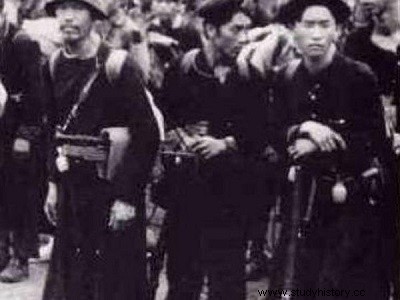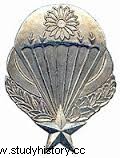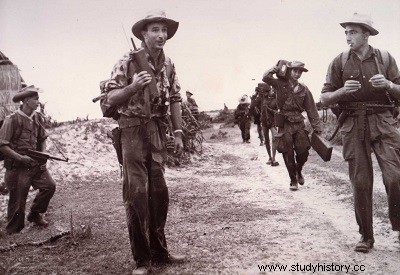
Currency Who dares wins
The group of mixed airborne commandos (or GCMA), was created on April 17, 1951 during the Indochina War by General de Lattre's staff, in agreement with the SDECE, on the basis of the proposals of Captain Déodat du Puy -Montbrun. The workforce is made up of native Indochinese (Hmong or Mèo, Tai and Laotian partisans for the most part) and the European executives come mainly from paratrooper units and in particular from the 11th Shock.

Creation and different denominations
April 17, 1951, creation of the mixed airborne commando group (GCMA),
December 12, 1953, the GCMA becomes a mixed intervention group (GMI),
21 July 1954:disbandment of the unit.
At the end of numerous operations, several unit leaders noted the unsuitability of the troops of the French Union for combat in the Upper Region of Indochina. Thus, the lack of adaptation would be tactical in particular. Battalion commander Bréchignac, commanding the 2/1e RCP, remarked that the relief and especially the vegetation of the Black Thai country generally made rapid maneuvering at battalion level difficult; the destruction of the adversary is therefore rarely obtained by envelopment. Battalion Commander Bloch, commanding the 2nd BEP develops more deeply the difficulties encountered in the field:
The well-known characteristic of this region is its lack of routes. The tracks are very poorly known, the maps being very incomplete and false and the guides have never been of much help, nor have the few inhabitants encountered... Reconnaissances in force of a group were often linked to a single track with moving in column by one. This resulted in a considerable stretching of the device which, together with the difficulties resulting from the terrain, made connections difficult... The only maneuver possible, in many cases, is the "telescopic" maneuver. In addition, the progression in areas very favorable to large ambushes, the favorite weapon of the Viet Minh, quickly leads to great fatigue and nervous tension in the operatives who often react less quickly.
Any attempt to maneuver is therefore annihilated. But what is valid for movement is also valid for fire, both in the field of fire support and in the field of air support. A major problem also affects the French expeditionary force:the poor quality of radio links. "The range of radio links is very considerably reduced by the relief, the vegetation, and very often the atmospheric conditions, in particular from 4 p.m.
In total, everything that constitutes d "other places, the strength of a battalion of the expeditionary force, in particular its ability to manoeuvre, its firepower, its cohesion, all these factors of superiority are practically reduced to nothing in the Upper Region. In his own report, summarizing in summarizing the various parameters mentioned by his subordinates, General Gilles expresses himself as follows:
The war in the Upper Region subjected our infantry units to harsh tests for which they were not always prepared... Accustomed to close-knit formations, reciprocal support and easy-to-see liaisons in the Delta, our units most often lacked the necessary maneuvering qualities... The Upper Region, by imposing on our infantry a fight without its usual support, appears eminently favorable to the adversary accustomed to fighting without artillery, without modern means of transport, and particularly trained in close combat.
All these reports oblige the command to abandon the traditional methods. It is high time to apply more suitable methods. To the guerrilla warfare implemented by the Viet Minh with the voluntary or forced help of the populations, we must oppose the counter-guerrilla warfare in which the native can only be a leading element. Very early on, volunteers were recruited from the mountain ethnic groups and Thai, Muong and Nung units were created. But it is not a question for the French command of using the native as a regular soldier but as a partisan because on the tactical level, according to Colonel Daillier, who deals with reconnaissance and intelligence missions :
Deep reconnaissance would be much more efficiently carried out by indigenous units who know the country very well and for which the problem of supply would be simplified...
Surveillance is obtained by the installation, on possible axes of infiltration, of light native formations... Belonging to the same population, these commandos can more easily collect information.
By developing the counter-guerrilla on a large scale within its various maquis, the GCMA will be able to apply this basic principle:to use the native in his traditional environment by giving him the means to highlight his own capacities, his rusticity , his endurance, his flexibility, his hunting instinct and, above all, his perfect knowledge of the natural environment In the spring of 1950, in Indochina, the war got bogged down and tensions arose between the French and Americans over independence from this country. The General Directorate of Documentation, created at the beginning of the year under the leadership of Colonel Gracieux, endeavors to coordinate the action of the civilian and military intelligence services which abound. In order to neutralize the revolutionary action of the Viet Minh, the high command decided to adopt a new tactic, based on psychological action and the use of special units trained in “unconventional warfare”. On April 7, 1951, General de Lattre de Tassigny, High Commissioner and Commander-in-Chief of the French Army in Indochina, signed decision 174:
“In agreement with the general management of the SDECE of the Presidency of the Council, and by analogy with the metropolitan organization, an “action service” was created from April 10, 1951 and integrated into the already existing services of the SDECE in Indochina. The “action service” is entirely at the disposal of the Commander-in-Chief. »
Commander Henri Fille-Lambie, head of the action department of the SDECE in mainland France, joined Indochina to set up this new structure. A unit, responsible for carrying out the operations mounted by the local action service, is formed under the name of the Airborne Mixed Commando Group. The Groupement quickly became the meeting place for all the Chinese or former 11th Shock who were dragging their gaiters through Indochina.

In 1952, the GCMA evoked the need to “create in the Viet Minh occupation zone an organization that would allow us to control it”. It is therefore a question, starting from the axiom stipulating that "in the face of a popular movement, only a popular movement can win", to use the traditional opposition existing between the peoples of the Upper Region and the Vietnamese of the plain . The fact of using these populations to thwart the Viet Minh advance is an original and roundabout way that the GCMA masterfully orchestrates and by which the French command will use on many occasions. As Sun Zi stated in his treatise on the art of war:
"The first to know how to exploit the circuitous and direct routes wins the victory, such is the art of armed struggle. »
However, the GCMA encounters many difficulties in setting up its commandos:
hostility of the military hierarchy to unorthodox warlike activities,
shortage of cadres who know the particularities of the multiple ethnic groups inhabiting Indochina, ...
Faced with these handicaps, it is often adventurous and courageous non-commissioned officers who will organize and take charge of the operations of their commando of several hundred partisans, a mission initially devolved to senior officers.
Organization
Attached to the airborne troops, the GCMA, placed under the orders of Lieutenant-Colonel Grall, officially depends, for the employment of the Commander-in-Chief. But unofficially, it is under the orders of the Directorate General of Documentation, that is to say of the SDECE, entrusted to General Gracieux, who was at the Directorate of Colonial Troops one of the most ardent defenders of the creation of the Demi-Brigade Para-Colo de Bretagne, and who knows Indochina and its different ethnic groups perfectly.
The GCMA operates the center of Ty Wan, near Cape Saint-Jacques, set up by Captain Erouart of the 11th Shock intended for the training of native cadres and two Airborne Operational Sections, one South in Saigon with antennas in Touranne and Vientianne, the other North in Hanoi. The Americans maintain a liaison mission with the GCMA which provides significant material and financial support. The Groupement also has close relations with the British SAS in Malaysia. It trains pathfinders intended to guide paratroopers during their interventions.
Operations
In Annam, the combined operation Pirate, carried out on August 30, 1951 by elements of the GCMA and the BAPS allows the definitive occupation of the island of Cu Lao Ré which becomes the training center of the commandos of the GCMA from September .
On September 12, 1952, the 8th GCP was attached to the GCMA. The 1,100 men of Captains Le Borgne then Tourret were then engaged in commando-type actions.
During the summer of 1953, in Thai country, the anti-VM maquis initiated by the GCMA with the Thai, Nung and Meo populations are in full expansion. In May and June, the Servan and Malo maquis provide a significant boost to regain control of the province of Tranninh, by providing intelligence and remote security missions for the battalions engaged. Moreover, Colonel Kergaravat said in this regard:
“Here more than elsewhere, audacity is the rule, because we will find the help of the population in case of failure. »
In August, the maquis of Captain Hébert, on both sides of the RP 41 which leads to Tuan Giao and Dien Bien Phu, allowed the evacuation without firing a shot, by air, of the equipment and the units of the entrenched camp. by Nasam. From October, in their progress towards the Thai country by the RP 41, the Viet-Minh comes up against these maquis, some 2,500 partisans framed by four or five French non-commissioned officers. The latter will not receive any support from the command, apart from some air support actions limited by weather problems.
Name change
Prior to its name change, the GCMA Command reported directly to the Commander-in-Chief with respect to employment. The TAPI Commander was only responsible for manpower management and airborne training. The latter was also responsible for the training of the Vietnamese, Laotian and Cambodian parachute units created during 1951 and ensured the establishment and relief of the French personnel supervising these formations.
The reorganization of the Airborne Troops of Indochina, according to the views of the General Commander-in-Chief and more particularly of General Gilles, was carried out at the end of 1953. Thus, the GCMA left the TAPIs on December 1, 1953 to be placed directly under the authority of the commanding general.
It takes the title of Groupement Mixte d'Intervention on December 12. The organization of the GMI remains that of the GCMA with a staff and three operational air sections, a command company, four regional representations (Laos, North, Center and South Vietnam), two regional branches in Phong Saly and on the plateaus mountain dwellers, an Instruction Center located in Cap Saint-Jacques.
The GMI theoretically has 2,400 auxiliaries divided into 24 hundreds supervised by 430 Europeans and 620 "regular" natives. The boss of the GMI is the battalion chief Trinquier, his chief of staff, the battalion chief Bonnigal of the 3rd BPC. The French executives are practically all of TAP origin and for the most part come from the 11th Shock. On the other hand, the group practically lost control of the 8th GCP, which became the 8th Parachute Shock Battalion in August and which was engaged without interruption in conventional amphibious or land operations in the Delta.
Dien Bien Phu
Raymond Muelle, former member of the 1st choc and author of a number of books on military themes, shows to what extent the maquis of the GCMA and therefore, a fortiori the native employees, played an important role in the defense of Dien Bien Phu. He thus notes the enormous tactical error made by the Command which, according to him, neglected these men:
Division 316 of the Viet-Minh en route to Dien Bien Phu intervenes; on November 15, the maquis collapsed. For six weeks their resistance has exasperated the enemy. Supporters and populations will suffer appalling reprisals. The lucky ones will be used as coolies and will go and dig trenches under fire around the French positions in the entrenched camp. Captured European non-commissioned officers will be tried by a "people's court" and executed. The survivors will try, on order, to reach Dien Bien Phu. Those who succeed will suffer the fate of the garrison.
Thus, the failure of the Command leaves the way open to the 316 division and the Viet-Minh reinforcements which will reach the outskirts of the basin a few days later.
This serious tactical gap in the plans of the General Staff also demonstrates, if need be, the lack of interest of those responsible for the fight led by the natives, for the psychology of the populations and the sacrifices of the men in the field. who fought with them. Not only can one think that these human lives were hardly taken into account, but there was also a lack of knowledge, a dramatic maladjustment of these responsible officers, prisoners of routine and prefabricated schemes.
Defeat
The GCMA is a success and fulfills its role perfectly. As Lieutenant-Colonel Trinquier states:
“The Viet Minh has always based its action on a politico-military system. For the first time, we officially oppose him with a weapon adapted to the kind of fight he imposes on us. »
Unfortunately, this weapon was used very late and the defeat abruptly interrupts its activities. Trinquier tries to link up with the CIA (which already provides important logistics), but it is already too late. The dissolution of the GMI is effective on July 21, 1954 following the Geneva agreements ending the war in Indochina.
However, the paradox of this defeat should be noted. While the French Union was losing in a classic fight at Dien Bien Phu, the native maquis were effectively leading the counter-guerrilla in the Upper Region.
Fighting techniques
The combat techniques used at the start of the Indochina War are the same as those used by the military during the Second World War. It will take several years for civil and military leaders to admit that this is a new kind of war which is not just a confrontation between two armies intended to conquer a territory, the issue is now the population control. The forerunners of this method were Colonel Belleux and Fourcaud of the SDECE who, inspired by their experience in the Resistance, set up an action service at the end of 1950 which established contacts with the indigenous populations hostile to the Vietminh. . The next objective is to form maquis responsible for carrying out guerrilla actions.
When it was created, the missions entrusted to the GCMA boiled down to guerrilla and sabotage operations and the establishment of escape networks, in particular by the commandos of the coastal zone.
Missions
During the first quarter of 1952, the group published an activity report on the practice of guerrilla warfare against the Viet Minh in Indochina. This text defines the doctrine of the action carried out within the framework of the special services:
The action is "first a form of combat... It aims to destroy enemy potential where conventional means cannot for one reason or another reach it".
From December 1953, when the unit became a mixed intervention group (GMI), the command widened the range of missions allocated to it, specifying that its elements must henceforth:
“Prepare, organize, set up and order elements likely to:carry out maquis; traveling guerrillas; special missions (in particular sabotage) by individual elements or very light teams infiltrated clandestinely; set up escape routes; take part in psychological warfare on orders. »
This unit then becomes a Service Action in its own right, a branch of the special services. It is responsible for setting up in Indochina a special form of warfare different from that employed by conventional military structures.
The maquis
The GCMA will throughout its existence constitute resistance groups within the Indochinese populations hostile to the Vietminh movement. These are mainly the Meo, Thai or Nung minorities. During a reconnaissance mission to the Chinese border, the hundred commanded by Captain Paul Mourier who joined the GCMA in 1952, discovered a nationalist Chinese regiment, led by Colonel Yen and taking refuge in Muong Nhié, which finally joined the French in February 1954.
These maquis, established in Tonkin and Laos, harass Vietminh troops and also participate in conventional operations such as the Na San evacuation operation and the attempted destruction of the Lao Kay bridge on October 6, 1953
The warrior qualities are not the same among the different ethnic groups of the Upper Region:the Thai is rather peaceful while the Meo, living in the summits, is more fierce and independent. Nevertheless, any native can render great service. Entrusting the partisan with simple missions corresponding to his natural know-how, such is the idea shared by Captain Hébert and Colonel Berteil, who jointly organize the guerrilla warfare in the Black Thai country. Later, the GOMRN set them the missions for which they had to prepare:
"Counter-guerrillas should initially aim above all for intelligence, assassination of notorious Viet-minh, rallying of the Du-Kich, infiltrating units politico-military, interception of SR and Viet Minh liaison agents, destruction of telephone lines, counter-propaganda, etc. After running in, these elements will give their activities a more marked operational character in connection with regular units... »
